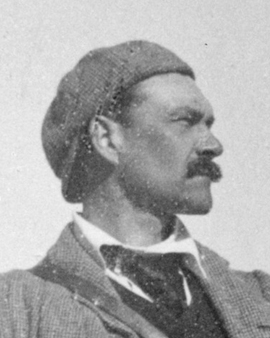Akseli Gallen-Kallela, who grew up in Tyrvää, Finland, knew at an early age that he wanted to become a painter. But his father, a respected lawyer and police chief, prevented it for the time being and sent him to Helsinki to grammar school at the age of eleven. Three years later his father died and the now 14-year-old took drawing courses at the Finnish Art Society and received private lessons from Adolf von Becker, a painter and art teacher. Akseli's real name was Axel Waldemar Gallén. He was born in Pori, Finland in 1865 into a Swedish-speaking family. As he thought his name did not sound Finnish enough, he later changed it to Akseli Gallen-Kallela. Like so many young artists, he was drawn to Paris, where he studied painting at the Académie Julian. During this time he met several Scandinavian artists, including the Finnish painter Albert Edelfelt and AAugust Strindberg, one of the world's foremost playwrights. Gallen-Kallela was fascinated by the Kalevala, the national epic of Finland and one of the most important literary works. He decided to illustrate this epic.
When he married Mary Slöör in 1890, their honeymoon took them to East Karelia. There he began to collect material for the Kalevala. This creative phase is marked by the influences of the mythological tales of the Kalevala and is evident in romantic depictions of heroes and lovely landscape paintings. In 1894 Gallen-Kallela travelled to Berlin to organise a joint exhibition with the Norwegian painter Edvard Munch. Four months later this trip came to an abrupt end. In a telegram he was informed of the death of his daughter Impi Marjatta. She died of diphtheria. This tragic event left deep scars, which would be reflected in his future works. His paintings became more violent and darker. One of his most famous works, "The Defence of Sampo", dates from this period. Together with his wife he travelled to London and Florence. For the 1900 World's Fair in Paris, he painted frescoes for the Finnish pavilion, securing his reputation as a Finnish artist.
He moved to Paris with his family in 1908, but fled an almost hostile atmosphere to Nairobi in Kenya, where he embraced Expressionism and painted more than 150 pictures. While on a big-game hunt, he met former American president Theodore Roosevelt. After their African adventures, the entire family headed to the United States, where they settled in the artist colony of Taos, New Mexico. Even under the scorching desert sun, Gallen-Kallela devoted himself to his paintings for the Kalevala. But he also portrayed the Indian chief Siu Ohutaa, which caused quite a stir. In 1926 the family returned to Tarvaspää, and four years later Akseli Gallen-Kallela died of pneumonia. His studio and the house in Tarvaspää were opened as a museum in 1961, where one can get an insight into the artist's infinitely large creative range. Among them are paintings, graphics, sculptures and prints. The change of art from the 19th to the 20th century becomes almost tangible there.
×





.jpg)
.jpg)
.jpg)
.jpg)
_1902_-_(MeisterDrucke-890060).jpg)
_1902_-_(MeisterDrucke-890060).jpg)
_-_(MeisterDrucke-907465).jpg)
_-_(MeisterDrucke-907465).jpg)
.jpg)
.jpg)
.jpg)
.jpg)
.jpg)
.jpg)
.jpg)
.jpg)
.jpg)
.jpg)
.jpg)
.jpg)
.jpg)
.jpg)
.jpg)
.jpg)
.jpg)
.jpg)
.jpg)
.jpg)
.jpg)
.jpg)
.jpg)
.jpg)
.jpg)
.jpg)
.jpg)
.jpg)
.jpg)
.jpg)
.jpg)
.jpg)
.jpg)
.jpg)
.jpg)
.jpg)
.jpg)
.jpg)
.jpg)
.jpg)
.jpg)
.jpg)
.jpg)
.jpg)
_Oil_on_canv_-_(MeisterDrucke-1028733).jpg)
_Oil_on_canv_-_(MeisterDrucke-1028733).jpg)
.jpg)
.jpg)
.jpg)
.jpg)
.jpg)
.jpg)
_(Maxime_Gorki)_-_Gallen-Kallela_A_-_(MeisterDrucke-1028410).jpg)
_(Maxime_Gorki)_-_Gallen-Kallela_A_-_(MeisterDrucke-1028410).jpg)
.jpg)
.jpg)
.jpg)
.jpg)
_-_(MeisterDrucke-941646).jpg)
_-_(MeisterDrucke-941646).jpg)
.jpg)
.jpg)
.jpg)
.jpg)
.jpg)
.jpg)
.jpg)
.jpg)
.jpg)
.jpg)
.jpg)
.jpg)
.jpg)
.jpg)
.jpg)
.jpg)
.jpg)
.jpg)
.jpg)
.jpg)
_-_(MeisterDrucke-636348).jpg)
_-_(MeisterDrucke-636348).jpg)
.jpg)
.jpg)
.jpg)
.jpg)
.jpg)
.jpg)
.jpg)
.jpg)
.jpg)
.jpg)
.jpg)
.jpg)
.jpg)
.jpg)
.jpg)
.jpg)
.jpg)
.jpg)
.jpg)
.jpg)
_-_(MeisterDrucke-1170710).jpg)
_-_(MeisterDrucke-1170710).jpg)
.jpg)
.jpg)
.jpg)
.jpg)
.jpg)
.jpg)
.jpg)
.jpg)
.jpg)
.jpg)
.jpg)
.jpg)
.jpg)
.jpg)
.jpg)
.jpg)
.jpg)
.jpg)
.jpg)
.jpg)
.jpg)
.jpg)
.jpg)
.jpg)
.jpg)
.jpg)
.jpg)
.jpg)
.jpg)
.jpg)
_-_(MeisterDrucke-959843).jpg)
_-_(MeisterDrucke-959843).jpg)
.jpg)
.jpg)
.jpg)
.jpg)
.jpg)
.jpg)
.jpg)
.jpg)
.jpg)
.jpg)
.jpg)
.jpg)
.jpg)
.jpg)
.jpg)
.jpg)
.jpg)
.jpg)
.jpg)
.jpg)
.jpg)
.jpg)
.jpg)
.jpg)
.jpg)
.jpg)
.jpg)
.jpg)
.jpg)
.jpg)
.jpg)
.jpg)
.jpg)
.jpg)
.jpg)
.jpg)
.jpg)
.jpg)
.jpg)
.jpg)
_-_Peinture_de_Akseli_(Axel-Gallen_Axel_Gal_-_(MeisterDrucke-1322735).jpg)
_-_Peinture_de_Akseli_(Axel-Gallen_Axel_Gal_-_(MeisterDrucke-1322735).jpg)
.jpg)
.jpg)
.jpg)
.jpg)
.jpg)
.jpg)
.jpg)
.jpg)
.jpg)
.jpg)
.jpg)
.jpg)
.jpg)
.jpg)






